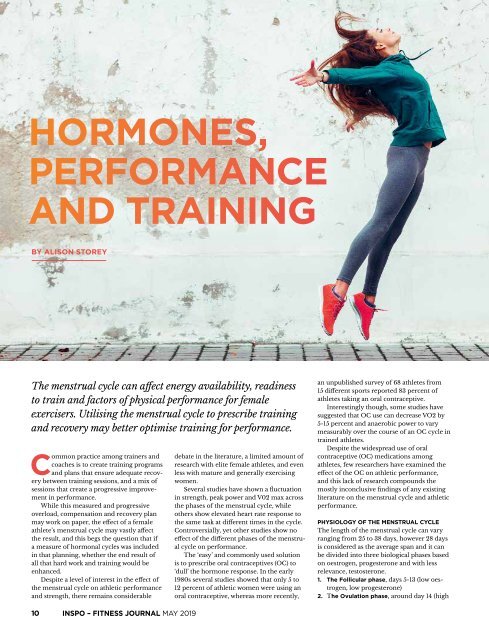INSPO Fitness Journal May 2019
Everything from nutrition, beauty, home and workplace wellbeing to health, performance – and so much more.
Everything from nutrition, beauty, home and workplace wellbeing to health, performance – and so much more.
Create successful ePaper yourself
Turn your PDF publications into a flip-book with our unique Google optimized e-Paper software.
HORMONES,<br />
PERFORMANCE<br />
AND TRAINING<br />
BY ALISON STOREY<br />
The menstrual cycle can affect energy availability, readiness<br />
to train and factors of physical performance for female<br />
exercisers. Utilising the menstrual cycle to prescribe training<br />
and recovery may better optimise training for performance.<br />
Common practice among trainers and<br />
coaches is to create training programs<br />
and plans that ensure adequate recovery<br />
between training sessions, and a mix of<br />
sessions that create a progressive improvement<br />
in performance.<br />
While this measured and progressive<br />
overload, compensation and recovery plan<br />
may work on paper, the effect of a female<br />
athlete’s menstrual cycle may vastly affect<br />
the result, and this begs the question that if<br />
a measure of hormonal cycles was included<br />
in that planning, whether the end result of<br />
all that hard work and training would be<br />
enhanced.<br />
Despite a level of interest in the effect of<br />
the menstrual cycle on athletic performance<br />
and strength, there remains considerable<br />
debate in the literature, a limited amount of<br />
research with elite female athletes, and even<br />
less with mature and generally exercising<br />
women.<br />
Several studies have shown a fluctuation<br />
in strength, peak power and V02 max across<br />
the phases of the menstrual cycle, while<br />
others show elevated heart rate response to<br />
the same task at different times in the cycle.<br />
Controversially, yet other studies show no<br />
effect of the different phases of the menstrual<br />
cycle on performance.<br />
The ‘easy’ and commonly used solution<br />
is to prescribe oral contraceptives (OC) to<br />
‘dull’ the hormone response. In the early<br />
1980s several studies showed that only 5 to<br />
12 percent of athletic women were using an<br />
oral contraceptive, whereas more recently,<br />
an unpublished survey of 68 athletes from<br />
15 different sports reported 83 percent of<br />
athletes taking an oral contraceptive.<br />
Interestingly though, some studies have<br />
suggested that OC use can decrease VO2 by<br />
5-15 percent and anaerobic power to vary<br />
measurably over the course of an OC cycle in<br />
trained athletes.<br />
Despite the widespread use of oral<br />
contraceptive (OC) medications among<br />
athletes, few researchers have examined the<br />
effect of the OC on athletic performance,<br />
and this lack of research compounds the<br />
mostly inconclusive findings of any existing<br />
literature on the menstrual cycle and athletic<br />
performance.<br />
PHYSIOLOGY OF THE MENSTRUAL CYCLE<br />
The length of the menstrual cycle can vary<br />
ranging from 25 to 38 days, however 28 days<br />
is considered as the average span and it can<br />
be divided into three biological phases based<br />
on oestrogen, progesterone and with less<br />
relevance, testosterone.<br />
1. The Follicular phase, days 5-13 (low oestrogen,<br />
low progesterone)<br />
2. The Ovulation phase, around day 14 (high<br />
10 <strong>INSPO</strong> – FITNESS JOURNAL MAY <strong>2019</strong>


















